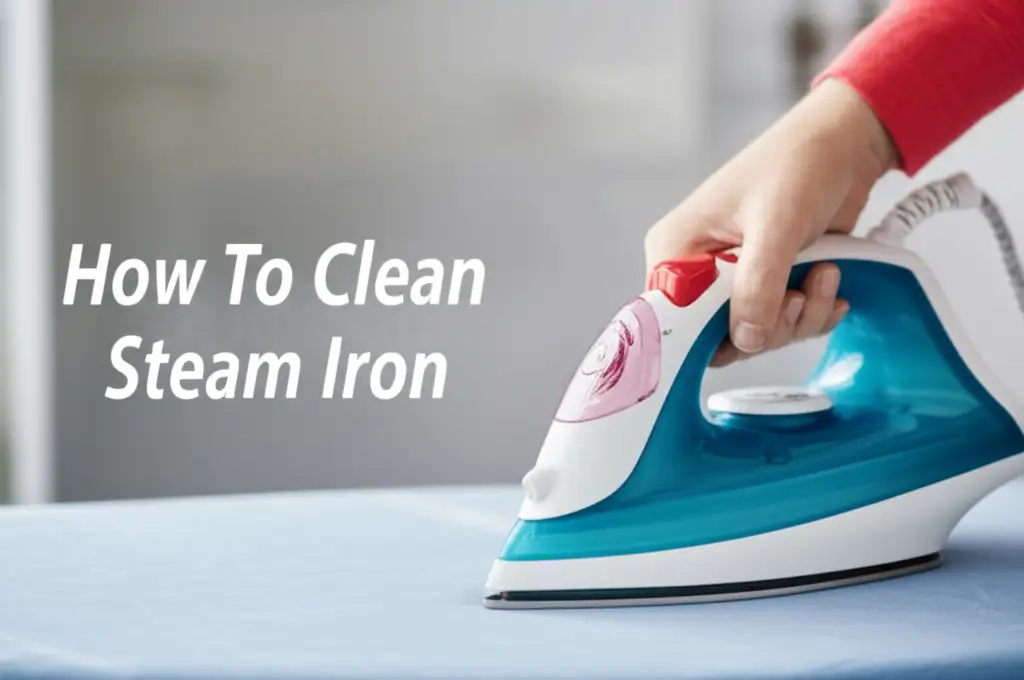· Home Appliance Care · 15 min read
How To Clean Steam Iron

Keep Your Steam Iron Sparkling: A Cleaning Guide
A clean steam iron makes all the difference when ironing clothes. I know how frustrating it is when my iron leaves marks on fabrics instead of smooth results. A dirty soleplate can transfer grime. Mineral buildup inside the water tank can also clog steam vents. This stops your iron from working its best. Learning how to clean a steam iron properly ensures perfect results every time. This guide helps you tackle common iron cleaning challenges. We will cover cleaning the soleplate, descaling the water tank, and clearing steam vents. Follow these steps to keep your iron in top condition.
Takeaway
- Regularly inspect your steam iron for soleplate stains and water tank mineral buildup.
- Clean the soleplate using household items like baking soda, vinegar, or toothpaste.
- Descale the iron’s water tank periodically with a vinegar solution to prevent clogs.
- Clear steam vents with cotton swabs or a toothpick for consistent steam output.
- Store your iron properly and use appropriate water to extend its life.
Cleaning your steam iron involves removing buildup from its soleplate and descaling the internal water tank. You can use simple household items such as baking soda paste, white vinegar, or even toothpaste. This process restores smooth gliding and prevents fabric stains. It also maintains efficient steam production.
Understanding Why Your Steam Iron Needs Cleaning
Your steam iron works hard to remove wrinkles. Over time, it collects grime. This grime comes from many sources. Starch, fabric fibers, and mineral deposits build up on the iron. A dirty soleplate can stick to clothes. It can also leave brown or yellow marks. This ruins your freshly washed items.
Mineral deposits often come from hard water. Tap water contains minerals like calcium and magnesium. These minerals form scale inside the iron’s water tank. This scale can block steam vents. When vents are blocked, your iron produces less steam. It may even spit out mineral flakes onto your clothes. Regular cleaning prevents these problems. It keeps your iron performing like new.
Common Stains on Iron Soleplates
The soleplate is the bottom part of your iron. It touches your clothes. This surface can get dirty quickly. Stains often come from melted synthetic fabrics. Sometimes, starch residue or fabric sizing builds up. These create a sticky, dull layer. This layer makes the iron glide poorly. It also transfers dirt to clean garments. Burnt marks are also common. These occur when the iron is too hot for the fabric. These burnt spots are hard to remove. They require specific cleaning methods.
The Impact of Hard Water
Hard water is a big enemy for steam irons. It contains many dissolved minerals. When water heats up, these minerals separate. They form a hard, crusty deposit called limescale. Limescale sticks to the inside of the water tank. It also clogs the tiny steam holes on the soleplate. This reduces steam output. It can also cause the iron to spit out white or brown particles. These particles can stain your clothes. Using distilled water helps prevent this buildup. However, regular descaling remains important.
Preparing Your Steam Iron for Cleaning
Before you start any cleaning, safety comes first. I always make sure the iron is completely cool. A hot iron can cause severe burns. It also needs to be unplugged from the wall socket. This removes any risk of electric shock. Never clean an iron while it is still plugged in.
Once the iron is cool and unplugged, empty its water tank. Tip the iron upside down over a sink. Pour out any remaining water. Some irons have a self-clean function. This function helps flush out loose mineral deposits. You can use it before a deep clean. This initial preparation makes the cleaning process safer and more effective.
Safety Precautions First
Safety is not just a suggestion; it is a rule. You must always handle electrical appliances with care. Ensure your iron is not just off, but unplugged. Wait at least 30 minutes for it to cool down completely. Even if it feels cool to the touch, internal components might still retain heat. Using a damp cloth on a hot iron can create steam. This steam can burn your skin. Protect your hands with gloves if you use cleaning agents. Some cleaners can irritate skin. Always read labels on commercial cleaning products.
Emptying the Water Tank
Emptying the water tank prevents spills. It also makes the iron lighter and easier to handle. Most irons have a fill hole on the top. You can tilt the iron and let the water drain out. For irons with a self-clean button, follow your iron’s manual. This function often involves filling the tank, heating the iron, and then pressing the button. It forces steam and water through the vents. This can push out loose debris. Perform this step in a sink. You do not want mineral water all over your floor. Emptying the tank fully ensures your cleaning solution works without dilution. It also prevents hot water from spraying out during cleaning.
Cleaning the Steam Iron Soleplate: Removing Stains and Residue
The soleplate often shows the most wear. Stains and stickiness are common problems. Many household items work well to clean this surface. You can use baking soda, vinegar, or even toothpaste. These items are gentle yet effective. They lift away grime without scratching the soleplate. Always test a small area first if you are unsure. This protects your iron’s finish.
For minor stains, a simple wipe with a damp cloth may suffice. For tougher spots, a bit more effort is needed. Remember to wipe off all cleaning residues completely. Any leftover product can transfer to your clothes later. A clean soleplate helps your iron glide smoothly. It also prevents new stains on your fabrics.
Baking Soda Paste Method
Baking soda is a mild abrasive. It works well for sticky or slightly burnt soleplates. I mix two tablespoons of baking soda with one tablespoon of water. This creates a thick paste. I apply this paste to the soleplate. I pay special attention to stained areas. I use a soft cloth or a non-abrasive sponge. I gently rub the paste over the soleplate. Do not scrub too hard, especially on non-stick surfaces. After rubbing, I let the paste sit for a few minutes. Then, I wipe it off with a damp cloth. I make sure no baking soda remains. This method often removes sticky residue and light scorch marks.
Vinegar and Salt Solution for Stubborn Marks
For more stubborn marks, a vinegar and salt mixture works wonders. I mix equal parts white vinegar and salt in a small bowl. I heat this mixture slightly. This helps the salt dissolve. I dip a soft cloth into the warm solution. Then I rub it over the soleplate. The salt acts as a gentle abrasive. The vinegar dissolves mineral deposits and stains. This solution is particularly good for burnt-on residue. It helps clean burnt material from the iron plate. For more specific guidance on tough stains, you can also explore how to clean a non-stick iron plate when burnt. I continue rubbing until the stains disappear. After cleaning, I wipe the soleplate thoroughly with a clean, damp cloth. I remove all traces of salt and vinegar.
Using Toothpaste for a Polished Finish
Toothpaste is a surprising but effective soleplate cleaner. It contains mild abrasives that can remove grime. I apply a small amount of white toothpaste directly to the soleplate. I use a soft cloth to rub it in. I focus on discolored areas or sticky spots. The toothpaste helps polish the surface. It lifts off dirt and minor scorch marks. For a detailed guide on this unique method, learn how to clean an iron plate with toothpaste. After rubbing for a few minutes, I wipe away the toothpaste with a damp cloth. Make sure all toothpaste residue is gone. This method leaves the soleplate smooth and clean. It gives it a nice shine.
Descaling the Steam Iron: Addressing Mineral Buildup in the Water Tank
The inside of your steam iron needs attention too. Hard water leaves mineral deposits in the water tank. These deposits can reduce steam performance. They can also clog the steam vents. Descaling removes this buildup. It restores your iron’s full steaming power. Regular descaling prevents long-term damage. It also extends the life of your appliance.
I recommend descaling your iron every few months. If you live in an area with very hard water, do it more often. White vinegar is the best and safest solution for this task. It breaks down mineral deposits effectively. This process is simple but crucial for iron maintenance.
White Vinegar Descaling Process
White vinegar is excellent for descaling. It is acidic and dissolves mineral deposits. I start by mixing equal parts white vinegar and distilled water. I fill the iron’s water tank with this solution. Do not fill it past the “max” line. I then turn on the iron to a medium heat setting. Let it heat up. Once hot, I press the steam button repeatedly. This forces the vinegar solution through the steam vents. You will see steam and possibly some brown or white flakes. These flakes are the mineral deposits breaking free. For a detailed guide on this process, see how to clean a steam iron water tank. I continue this process until the tank is empty. This flushes out much of the buildup.
Flushing Out the System
After using the vinegar solution, the next step is crucial. You must flush out all vinegar residue. Leftover vinegar can damage clothes. It can also leave a lingering smell. I refill the water tank with only distilled water. I turn the iron on again to a medium heat setting. I let it heat up. Then I press the steam button multiple times. I do this until the tank is empty. I repeat this flushing process two or three times. This ensures all vinegar and loosened mineral flakes are gone. I perform this over a sink or old towel. This prevents messy spills. Your iron is now descaled and ready for use.
Cleaning Steam Vents and Nozzles: Ensuring Smooth Steam Flow
Clogged steam vents are a common problem. Mineral deposits or fabric fibers can block these tiny holes. When vents are blocked, your iron produces uneven steam. It might even stop steaming altogether. Cleaning these vents is important. It ensures a consistent and strong steam output. This makes ironing easier and more effective.
You can use simple tools for this. A cotton swab, a toothpick, or a special vent cleaning tool works well. Be gentle when cleaning these delicate parts. Do not force anything into the holes. This could cause damage. Clear vents mean better steam. Better steam means smoother clothes.
Clearing Clogged Steam Holes
Once the soleplate is clean, look at the steam holes. You might see some white or brown residue. This is leftover mineral buildup. I use a cotton swab dipped in white vinegar. I gently push the tip into each steam hole. I twist it to dislodge any debris. For stubborn clogs, a toothpick can help. I carefully insert the toothpick into the hole. I wiggle it gently to break up the blockage. Never use metal objects. They can scratch or damage the soleplate. After clearing the holes, I wipe the soleplate again. I use a damp cloth to remove any loosened particles. This step is vital for optimal steam function.
After-Cleaning Care and Maintenance Tips
Cleaning your steam iron is a great start. Proper ongoing care makes the cleaning last longer. It also prevents future problems. A well-maintained iron works better. It lasts for many years. Simple habits can make a big difference. These habits save you time and effort in the long run.
Always store your iron correctly. Use the right type of water. Clean it regularly. These small steps protect your investment. They ensure your clothes always look their best. Following these tips keeps your iron ready for action.
Proper Water Usage
The type of water you use matters greatly. Tap water, especially hard water, causes mineral buildup. This is the main reason for internal iron problems. I always recommend using distilled water in your steam iron. Distilled water has no minerals. It prevents limescale from forming inside the tank. If you cannot get distilled water, use filtered or demineralized water. Some irons allow a mix of tap and distilled water. Check your iron’s manual for specific recommendations. Avoiding tap water extends your iron’s life significantly. It also reduces how often you need to descale.
Storing Your Iron Correctly
How you store your iron affects its longevity. Always store your iron upright. This prevents any remaining water from leaking out. It also protects the soleplate from scratches. Let the iron cool completely before storing it. Wrap the power cord neatly around the iron’s base. Do not wrap it too tightly. This prevents cord damage. Store the iron in a dry place. A cool, dry cupboard is ideal. Avoid humid environments. Humidity can cause rust or mold over time. Proper storage keeps your iron safe. It also keeps it ready for your next ironing session.
Troubleshooting Common Steam Iron Cleaning Issues
Sometimes, cleaning does not fix everything. You might face persistent stains. Or perhaps the steam vents remain clogged. Do not give up. There are a few more things you can try. These troubleshooting tips address common issues that might arise. They help you solve problems when standard cleaning methods fall short.
Knowing what to do in these situations saves you from buying a new iron. It empowers you to tackle stubborn problems. Remember, patience is key. A little extra effort can revive your iron’s performance.
When Stains Refuse to Go
Some soleplate stains are very stubborn. Melted plastic or synthetic fabrics can be difficult. If baking soda or vinegar did not work, try a commercial iron soleplate cleaner. These products are specifically formulated. They break down tough residues. Follow the product instructions carefully. Another trick is using a pencil eraser on cooled, stubborn marks. Gently rub the eraser over the mark. This can sometimes lift off sticky residue. For deeply embedded marks, consider using fine-grade sandpaper. This is a last resort. Use it very lightly and carefully. Apply it only to non-stick soleplates, not coated ones.
Persistent Clogging in Steam Vents
If steam vents remain clogged after descaling, the blockage is severe. The mineral deposits are likely hardened. You can try repeating the vinegar descaling process. Let the vinegar solution sit in the tank for a longer time. For example, let it sit for an hour. Then, perform the steaming and flushing steps again. For individual stubborn holes, use a dedicated iron cleaning tool. Some irons come with a small pin for clearing vents. If not, a sturdy sewing needle can work. Insert it carefully into the hole. Twist it gently to break up the clog. Be very careful not to enlarge or damage the hole. If these methods fail, consider professional repair. Or, it might be time for a new iron.
Iron Not Steaming Properly After Cleaning
After cleaning, your iron should steam well. If it does not, check a few things. First, make sure you used distilled water for the final flush. Tap water can reintroduce minerals quickly. Second, ensure the water tank is filled above the minimum line. Some irons need a certain water level to generate steam. Third, check the temperature setting. Steam irons need to reach a high temperature to produce steam. Lower settings might not activate the steam function. Finally, perform the self-clean cycle a few more times. This can dislodge any remaining hidden debris. If problems persist, the internal pump or heating element might have issues. This requires professional repair.
FAQ Section
How often should I clean my steam iron?
I recommend cleaning your steam iron every few months. If you use it daily or live in a hard water area, clean it more often. A good rule of thumb is every 1-2 months. Regular cleaning prevents mineral buildup and keeps your iron performing its best.
Can I use tap water in my steam iron?
Using tap water is not ideal. It contains minerals that cause limescale buildup inside your iron. This can clog vents and reduce steam output over time. I suggest using distilled water to extend your iron’s life and maintain its performance.
What causes brown stains on ironed clothes?
Brown stains usually come from mineral deposits. These deposits build up inside the iron’s water tank. They can spit out onto your clothes during steaming. Burnt fabric residue on the soleplate can also transfer brown marks. Regular cleaning prevents these issues.
Is it safe to use commercial iron cleaners?
Yes, many commercial iron cleaners are safe and effective. They are designed to remove specific stains or descaling issues. Always read the product instructions carefully. Make sure the cleaner is suitable for your iron’s soleplate type.
How do I remove melted fabric from my iron?
To remove melted fabric, first let the iron cool completely. Place a damp cloth over the melted spot. Gently reheat the iron to a low setting. This softens the melted fabric. Then, use a wooden or plastic spatula to scrape it off carefully. Do not use metal tools.
Conclusion
A clean steam iron transforms your ironing experience. It makes your tasks easier. It helps your clothes look sharp. We covered important steps to clean your steam iron thoroughly. You learned to tackle soleplate stains, descale mineral buildup, and clear steam vents. I find that taking the time for this maintenance pays off.
Remember, a little regular care goes a long way. Clean your iron regularly. Use distilled water. Store it properly. These simple habits keep your iron working at its peak. This helps you achieve wrinkle-free results every time. Keep your iron clean, and your clothes will thank you. Get started today. Your wardrobe will look great!
- iron cleaning
- steam iron maintenance
- appliance care
- descaling iron




